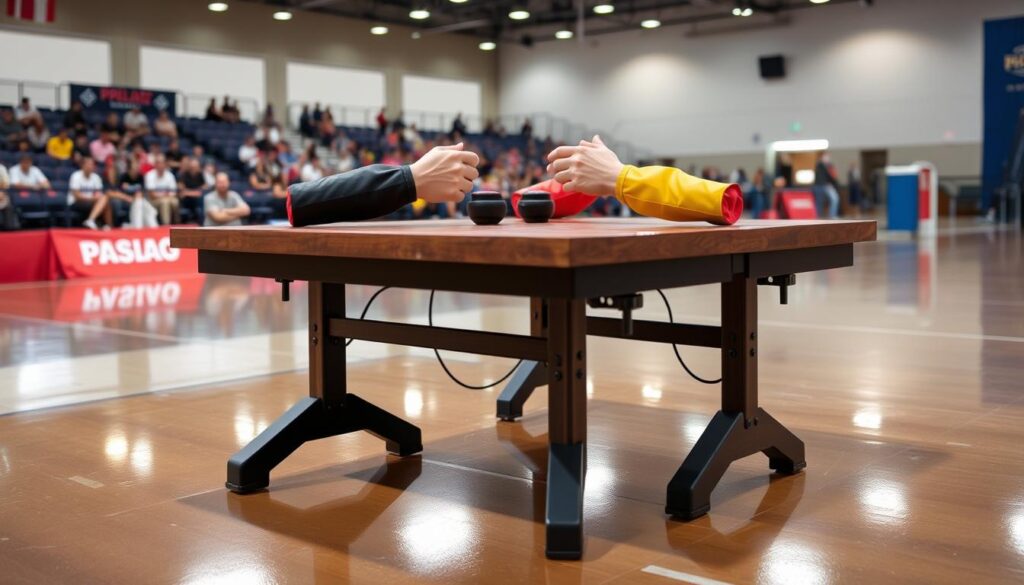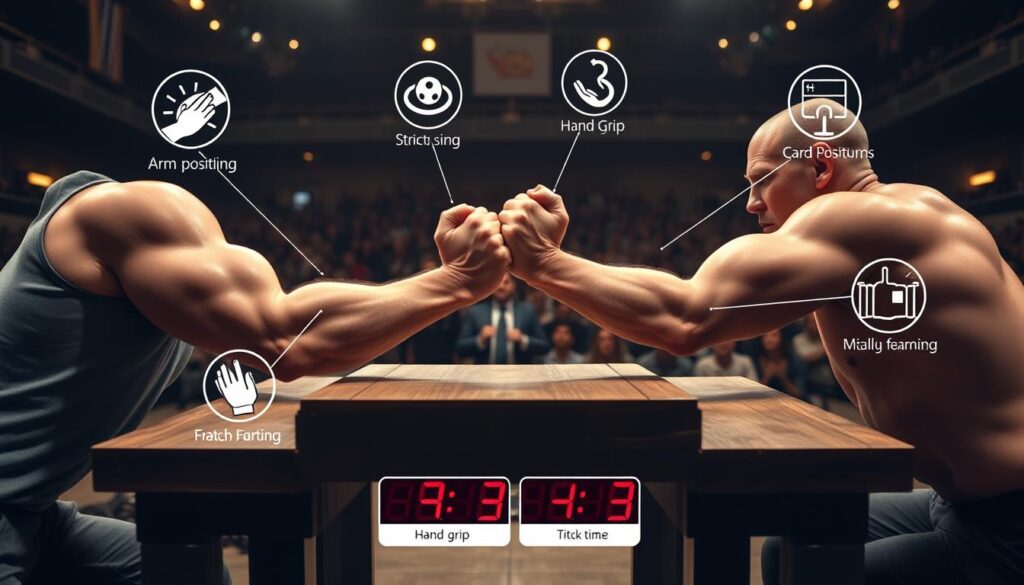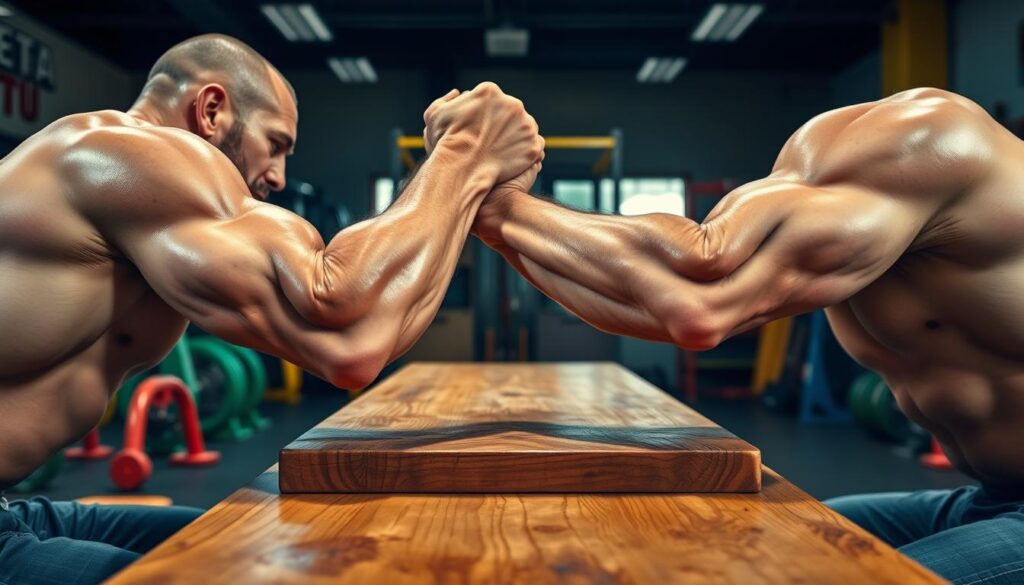Table arm wrestling is an exciting sport that tests both physical strength and smart strategies. Players lock arms and try to pin the other’s arm down, making for thrilling matches. It has gained fans worldwide, with both newbies and pros joining the action for its fun and community spirit.
To succeed in table arm wrestling, knowing the right techniques, the gear needed, and how to train is crucial. It offers great satisfaction whether you’re an experienced contender or just beginning.
Table of Contents
ToggleKey Takeaways
- Table arm wrestling combines strength, skill, and strategy.
- It’s a rapidly growing sport with amateur and professional events worldwide.
- Essential equipment, like arm wrestling tables, can vary in durability and design.
- Training programs and workout plans are available to enhance performance.
- Understanding arm wrestling techniques is key to success in competitions.
Understanding Table Arm Wrestling
Table arm wrestling is not just about strength. It blends precision, skill, and strategy. Competitors must learn arm wrestling rules for a fair and safe match. This knowledge lets them grasp the details in professional arm wrestling.
The size of the arm wrestling table affects the match. A standard table is 40 inches tall. Sit-down tables measure about 28 inches in height. The surface is 36 inches by 26 inches, giving space for the competitors. Elbow pads are also crucial, measuring 7 inches square and placed 2 inches from the edge. Pin pads offer extra support and are designed for best leverage.
It’s key to know the arm wrestling table layout. Hand pegs help with grip and stance, being 1 inch wide and 6 inches tall. They’re placed in the middle of the table edge. For contestants and fans alike, knowing the arm wrestling rules is essential. It deepens the appreciation for the competitors’ skills.
The International Federation of Armwrestling (IFA) makes the rules. They define roles like the Referee Panel and Tournament Head Referee. These officials ensure the matches run smoothly. Athletes must follow the rules closely. This includes how to handle protests and enforcing rules during contests.
History of Competitive Arm Wrestling
The history of arm wrestling is both long and fascinating. It stretches from ancient times to the present day. Early clues suggest it began in the Middle East and ancient Greece. In fact, images found in Egyptian tombs from around 2000 BC show people arm wrestling.
In Ancient Greece, wrestling was more than just muscle; it started with complex moves. As time went by, the focus shifted to hand strategies. This led to techniques like today’s arm wrestling. The ancient Greeks had a move called acrocheirismos. It involved catching the opponent’s fingers to win.
The sport grew as societies evolved. For instance, Japan had its own version, called udezumo. Old texts like the Kojiki, from 712 AD, mention it. During the Edo period, arm wrestling was popular in various art forms.
The 20th century brought formal recognition to arm wrestling. The first World Arm Wrestling Championship was in 1962, in Petaluma, California. This event was a big deal for arm wrestling. It brought the sport to the general public. In the same year, the World’s Wrist-wrestling Championship, Inc. held its first event.
Nowadays, arm wrestling has many formats, like tournaments and supermatches. Supermatches have 3 to 6 rounds and feature top athletes. These contests have different weight classes. They also have separate divisions for right and left hands. This makes the competition fair and exciting.
International events like the World Armwrestling League show how big the sport has become. Special tables have been designed for these tournaments. These tables have features like elbow pads, pin pads, and hand pegs. Knowing this helps us see the rich history and respect arm wrestling has earned as a sport.
Essential Arm Wrestling Equipment
Selecting proper arm wrestling gear is crucial for performance. Competitors should check their gear meets safety standards. This includes ensuring the support they need during matches is there. The table’s height, width, and padding matter as well.
Choosing the Right Arm Wrestling Table
There are many arm wrestling table options out there. They fit various needs and budgets. A good table ensures stability and comfort, following tournament rules. Here’s a quick look at some top choices:
| Table Name | Price | Usage | Pros | Cons |
|---|---|---|---|---|
| Innolife Armwrestling Table | $269.99 | Perfect for beginners | Extremely affordable, fantastic quality, durable | Tends to become slippery quickly |
| Mazurenko Armwrestling Table | $680-$800 | Professional grade | Top-notch build quality, stability, well worth the investment | Expensive, ships from Europe |
| Ezreal Standard Armwrestling Table | Varies | Solo training | Decent quality, reasonable price | Poor customer service, missing pieces in some cases |
| Legacy Armwrestling Table | Varies | Customizable for various preferences | Quality builds, manufactured in the USA | Slow configuration change between grips |
| Armbet Armwrestling Table | Varies | General use | Decent quality | Relatively expensive for the quality |
| Ezreal Adjustable Table Pulley | Varies | Solo training | Fantastic quality, versatile | No negative feedback reported |

Other Necessary Gear
Besides a quality table, you need the right gear. It’s all about safety and performance. Here are some essentials:
- Wrist Supports: They keep your grip strong during matches.
- Elbow Pads: They help avoid injuries in tough matches.
- Gloves: They enhance grip and shield your hands.
- Resistance Bands: They’re perfect for wrist and forearm training.
- Hand Grippers: Crucial for grip strength and endurance.
- WristMax Arm Wrestling Handle: It works hand and wrist muscles well.
Good equipment supports your body and prevents injuries. Choosing the right gear can lead to winning at the table.
Arm Wrestling Techniques for Success
Success in arm wrestling depends on knowing different techniques. Knowing when and how to use these techniques improves your chances of winning. The Top Roll and the Hook are important strategies in a match. They have different purposes.
The Top Roll Technique
The Top Roll is a popular method. It aims to get an upper hand by controlling the opponent’s wrist. To do this right, you have to roll their wrist back. You apply pressure fast and use leverage. This shows how arm strength is key in arm wrestling. Getting your hand and wrist in the right spot is also important.
Mastering the Hook
The Hook is different. It uses biceps power to pull the opponent closer. This method is great for beating someone using the Top Roll. Strong grip and wrist strength are key for the Hook. This move can help win tight matches. Focused training on arm muscles, including wrist and forearm, makes mastering the Hook possible. Practice is also essential.
Table Arm Wrestling: Strategies for Dominating Your Opponent
Knowing the right strategies is important for arm wrestling. It’s good to focus on physical skills and mental tactics. Train your hands and wrists twice a week to get stronger. This will help you beat your opponent.
Professional arm wrestlers use different moves to win. Moves like the shoulder press, the hook, and the top roll can give you an advantage. The top roll is great because it uses hand, finger, and wrist strength, not just bicep power. Keep your grip strong by aligning your forearm and wrist. This helps you last longer without getting tired.
Good competitors know when to make their move. Catching the right moment can change the whole game. Breathing evenly keeps you from getting tired too fast, so you can stay sharp. Sometimes, making noise can distract your opponent and give you an edge.
Using techniques right away makes it hard for your opponent to fight back. Turning your body so your shoulder matches your arm’s direction helps too. It uses your body weight to make you stronger. Training with special equipment gets you ready for real matches.
Doing certain exercises builds up important muscles. Wrist curls and dumbbell curls make your arms strong. Using the right moves and training well makes winning more likely. Statistics show that good strategy can improve your chances by up to 86% compared to just using strength.
| Technique | Effectiveness Rate | Use of Body Weight |
|---|---|---|
| Top Roll | 78% | 95% |
| Hook | 62% | 75% |
| General Techniques | 86% | 90% |
Key Arm Wrestling Rules to Know
It’s important to know arm wrestling rules for players and fans. These rules make sure every match is fair and follows basic arm wrestling etiquette. Knowing about starting positions, what grips are off-limits, and what counts as a legal win helps avoid problems. Following these rules keeps the game fair and safe for everyone.
Basic Rules of the Game
Arm wrestling matches go on until someone wins by pinning the other’s hand down. Competitors must hold hands in a certain way, showing the thumb knuckle. They also need to start with their shoulders lined up. A match doesn’t have a set time limit, and referees can stop a match if it’s not fair. They make sure everyone follows the arm wrestling rules.
Common Violations and Fouls
Knowing what counts as a foul is key to avoiding trouble. Major arm wrestling fouls include:
- Moving or lifting the elbow off the table
- Changing how you hold with your fingers while playing
- Not keeping your shoulder in the right place
- Using incorrect pressure
- Starting before the signal or delaying the game
If someone fouls three times, they could be out of the match. Smaller mistakes might just get a warning, but too many can lead to bigger penalties. Players should always play fair and respect the sport’s values.

Preparing for an Arm Wrestling Tournament
Getting ready to compete in arm wrestling tournaments is key. You need a good workout plan, the right food, and recovery methods. These help boost your strength and improve your technique and healing times.
Creating an Effective Arm Wrestling Workout Plan
Having a solid arm wrestling workout plan is vital. It builds strength and endurance. A three-day split routine works best. It lets athletes focus on different muscle groups and arm wrestling skills. The plan should cover:
- Strength training targeting forearm flexors, biceps, and shoulders
- Practice with a partner, focusing on offense and starting moves
- Technique drills using straps to boost performance
Exercises like hammer curls and planks target key muscles. Practicing moves like the “hook” and “top roll” sharpens your skills. Following a routine like Dariusz Muszczak’s, which mixes table work and strength training, can be beneficial.
Nutrition and Recovery Techniques
Diet is crucial for arm wrestling success. Eating proteins and complex carbs helps the body heal and stay energized. It’s best to lose no more than 10 lbs of water weight before weigh-ins. Exceeding this can drain your energy. For recovery, athletes should:
- Drink plenty of water for muscle repair
- Do stretching to increase flexibility
- Take breaks to help the body heal after hard training or matches
Recovery can take up to a week after big matches. By staying active and eating well, you can keep in top shape. Below, you’ll find a summary of a great training and recovery plan:
| Element | Description |
|---|---|
| Workout Frequency | Three days split routine focusing on different muscle groups |
| Technique Drills | Partner practice with emphasis on arm wrestling start techniques |
| Nutrition Focus | High protein and complex carbohydrates; hydration |
| Weight Management | Aiming to stay within 8-10 lbs of the target weight class |
| Recovery Time | Several days to a week after tournaments; active recovery strategies |
The Role of Grip Strength in Arm Wrestling
Grip strength is very important in arm wrestling performance. It lets you control your opponent’s hand and wrist. This control often decides who wins. Experts agree that having strong grip strength is key to winning in arm wrestling.
To get a stronger grip, you can do certain exercises. Using grip trainers and special lifting methods can help. These techniques are crucial for building the kind of strength needed in tough matches.
Studies show interesting facts about grip strength in male arm wrestlers. One study found that grip strength decreases after exercise. Initially, right hand grip strength was 51.1062 ± 1.69709, but it fell to 49.0437 ± 1.71770 after exercise (p=0.000). The left hand’s strength also dropped from 46.9000 ± 1.16179 to 45.8063 ± 1.30078, showing a significant change (p=0.000).
Many factors affect arm wrestling performance besides grip strength. These include reaction time, focus, and mental state. Important factors for grip strength are age, BMI, forearm size, and overall muscle strength. They are tied to what’s needed to do well in arm wrestling.
To build grip strength, experts suggest specific workout plans. A good plan might involve 5 sets of weight lifting doing 12 repetitions at 70% intensity. Adding mobility drills and exercises improves grip and helps with daily activities. This approach is similar to functional fitness routines.
| Grip Strength Measurement | Before Exercise | After Exercise |
|---|---|---|
| Right Hand Grip Strength | 51.1062 ± 1.69709 | 49.0437 ± 1.71770 |
| Left Hand Grip Strength | 46.9000 ± 1.16179 | 45.8063 ± 1.30078 |
Focus on strength in training can boost grip strength. This is a main goal for those wanting to excel in arm wrestling. By understanding these principles, athletes can better prepare and increase their chances of winning. Adding functional fitness to their routine can also strengthen their grip and overall performance.
For tips on enhancing functional fitness routines, visit this informative guide on functional fitness routines.
Conclusion
As we wrap up our look at table arm wrestling, remember it’s not all about strength. Skills, preparation, and smart strategies are also key. To succeed, knowing the sport’s history and rules is crucial. Plus, the right gear and techniques can really boost a wrestler’s game.
The world of arm wrestling is getting bigger with events by the World Armwrestling Federation and the Professional Armwrestling League. Fans can’t wait for matches in the King Of The Table series. These events show us that anyone can shine in arm wrestling with hard work and passion.
The arm wrestling community keeps growing and changing. It’s a place where new wrestlers can learn, compete, and honor the sport’s long tradition. With the right attitude and practice, they might just become stars in the booming arena of table arm wrestling.
FAQ
What is table arm wrestling?
Table arm wrestling is a sport where two people arm wrestle on a special table. It mixes arm strength, strategy, and technique. It’s not just about who is stronger.
What equipment do I need for competitive arm wrestling?
For arm wrestling, you will need a good table, wrist supports, elbow pads, and gloves. Choosing the right table is key for safety and doing well in the sport.
What are the basic rules of arm wrestling?
In arm wrestling, you must keep your elbow on the table and follow the rules. These rules help make the match fair and fun.
What techniques are important for success in arm wrestling?
Important techniques include the Top Roll and the Hook. The Top Roll uses wrist action for advantage. The Hook relies on bicep strength for control. Learning these can boost your game.
How can I increase my grip strength for arm wrestling?
Improve your grip by working with grip trainers, practicing lifting, and doing forearm exercises. A strong grip helps you control the match.
What should I include in my arm wrestling workout plan?
Your workout should focus on building up forearms, biceps, and shoulders. Also, work on grip endurance and strategy to get better at arm wrestling.
What nutrition is best for arm wrestling athletes?
Eat plenty of protein and complex carbs for energy and muscle building. Staying hydrated and eating recovery foods after workouts is crucial, too.
How important is strategy in arm wrestling?
Having a good strategy is key. It means knowing your opponent and adjusting your technique. The right mental and physical approach can lead to winning.
What are common violations in arm wrestling?
Watch out for false starts, illegal grips, and lifting your elbow. Knowing these rules keeps the game fair and avoids penalties.













